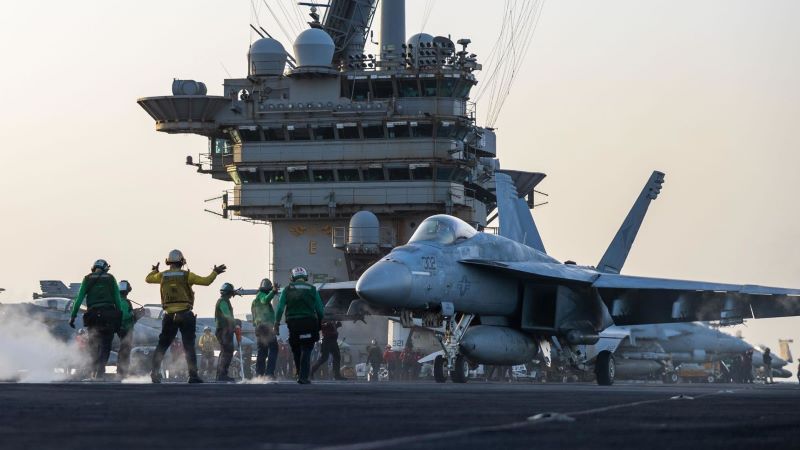On April 28, local time, the U.S. Navy issued a notice stating that an F/A-18E Super Hornet fighter belonging to the aircraft carrier USS Harry S. Truman crashed in the Red Sea during a mission. The accident did not result in any injuries, but the aircraft was destroyed in the crash. The accident did not result in any casualties, but caused serious damage to the equipment. The U.S. side has launched a full investigation into the incident. This incident has aroused a great deal of concern about the operational status of US aircraft carriers and the safety of shipboard operations.
Accident background
According to the U.S. Navy’s official briefing, the F/A-18E fighter jet was located in the hangar deck of the aircraft carrier “Truman” by the tractor for routine mobilization operations, ready to take off, and deployed or transferred to storage. However, during the towing operation, a malfunction or mishandling of the towing system caused the aircraft, along with the towing equipment, to lose control, slide off the edge of the ship, and crash directly into the Red Sea. The incident occurred while the carrier was conducting an emergency evasive maneuver aimed at avoiding a possible missile threat from Yemen’s Houthis. An anonymous Defense Ministry official said, “The sudden adjustment of the hull’s course in conjunction with poor coordination between the deck operators may have been one of the triggering factors for the accident.”
Fighter jet damage: worth more than $67 million
A crashed fighter for a F / F/A-18E “Super Hornet” (Super Hornet), for the U.S. military, is currently one of the main shipborne fighters, with strong air combat and ground attack capabilities. Publicly available information shows that this type of fighter aircraft unit price of more than 67 million U.S. dollars, with all-weather takeoff and landing, shipborne weapons systems and aerial refueling capabilities, is the U.S. military aviation combat system in the key assets. Although the aircraft and trailer crashed into the sea together, it was reported that no pilot was on board, and there were no serious injuries or deaths on board the ship, with only one sailor being treated for a bruised arm while attempting to brake.
The carrier’s operational status remains stable
A spokesman for the U.S. Navy emphasized in a statement that despite the equipment accident, the overall operational capability of the aircraft carrier “Truman” has not been materially affected, the operation of the carrier fleet is still maintained as normal, and the carrier fleet continues to perform the task of cruising and vigilance in the Red Sea. Currently, the fighter jet has been classified as “total loss,” and no decision has been made as to whether it will be salvaged. Naval engineering teams are assessing the hull structure for collateral damage and checking safety systems.
Successive accidents raise questions about safety
The crash was not the first during Truman’s current deployment. According to the military, the carrier has had several safety incidents since it deployed to the Red Sea in 2024:
- In December 2024, an F/A-18 fighter jet was mistakenly targeted and shot down by the USS Gettysburg guided missile cruiser’s air defense system over the Red Sea, but the pilot managed to eject and survive.
- In February 2025, the USS Truman suffered structural damage in a minor collision with a commercial freighter off Port Said, Egypt, resulting in the dismissal of her captain.
The crash raised questions about the USS Truman’s chain of command, deck scheduling capabilities, and fleet training status.

The Red Sea situation
“The USS Harry S. Truman is one of the main fleets deployed by U.S. Central Command (CENTCOM) to stabilize the Red Sea waters in the Middle East, and has been stationed in the Red Sea and Arabian Sea region since 2024, with its main missions including deterring Houthi forces in Yemen, escorting international merchant ships, and cooperating with coalition operations.
Between March and April 2025 alone, U.S. forces launched more than 800 airstrikes against Houthi targets in response to their missile attacks on international shipping. Against the backdrop of such a high-intensity deployment, the fleet’s operational tempo is tight, and the pressure has increased dramatically, and the frequency of various types of mishaps has triggered a rethinking of the military community’s logistical and security mechanisms.
Response and follow-up investigation
The U.S. Department of Naval Operations said it has set up a special investigation team to comprehensively verify the shipboard operating procedures, equipment stability, and duty safety training records. The Department of Defense said that although the incident was accidental, but did not find signs of intentional destruction or enemy attack, to rule out the possibility of external attacks. Some members of the House Armed Services Committee asked the Navy to submit its preliminary findings to Congress within 72 hours and to reassess carrier deck safety practices.
The U.S. public took to social media to express irony at the notion that “warplanes were dumped into the sea like luggage,” with one commenting, “The world’s most advanced carrier system has tens of millions of dollars of equipment in the water because of a trailer.”
Operational accident or systemic fatigue
Some military analysts have pointed out that the scheduling, takeoff, and landing of shipborne fighter jets is a high-risk operation, and any coordination errors may cause serious consequences. The current U.S. military aircraft carriers are deployed overseas in turn, in a state of high pressure and long-term fatigue, the operator’s attention has declined, inadequate equipment maintenance, and system aging problems are aggravating. The U.S. Navy should invest more in crew training, command coordination, and shipboard safety system intelligence in the future to reduce the recurrence of similar accidents.
Conclusion
This F/A-18E fighter plane crash into the sea did not cause casualties, but once again exposed the operational pressures and safety challenges of the U.S. military in a high-intensity overseas deployment environment. The specific cause of the accident, attribution of responsibility, and subsequent improvement measures require attention to the latest news. At the same time, the U.S. military must find a balance between ongoing external pressures and the aging of internal systems to ensure that its carrier fleet is truly capable of sustained, efficient, and reliable operations.













Leave a comment